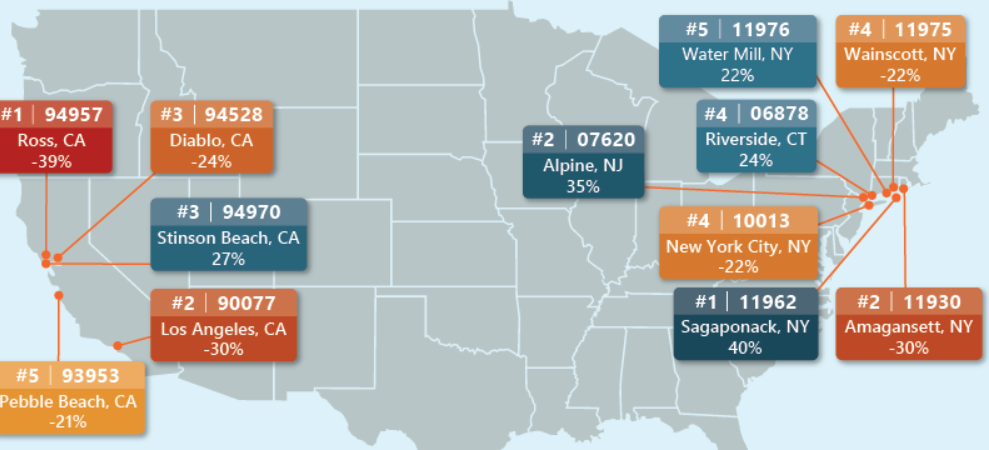In the vast tapestry of the United States Postal Service (USPS), zip codes serve as the threads that weave together the fabric of mail delivery. These numerical identifiers, crucial for efficient sorting and routing, vary in number from state to state, reflecting population density, geographical expanse, and historical development. In this exclusive article, we embark on a journey to uncover the state with the most zip codes, exploring the factors that contribute to its postal complexity, and the implications for its residents and businesses.
Contents
The Winner: California Claims the Crown
California, the Golden State, renowned for its diverse landscapes, bustling cities, and sprawling suburbs, holds the distinction of being the state with the most zip codes. With a staggering 1,955 unique zip codes assigned within its borders, California’s postal network dwarfs that of any other state, reflecting its immense population and vast geographical expanse. From the bustling metropolis of Los Angeles to the serene coastal towns of Monterey, and from the sun-kissed vineyards of Napa Valley to the towering peaks of the Sierra Nevada, California’s zip codes encompass a rich tapestry of communities, each with its unique character and postal needs.
Factors Contributing to California’s Zip Code Dominance
Several factors contribute to California’s status as the state with the most zip codes:
- Population Density: California boasts the largest population of any state in the US, with nearly 40 million residents calling it home. This dense population necessitates a vast network of zip codes to ensure efficient mail delivery to every corner of the state.
- Geographical Expanse: California is the third-largest state in the US by area, encompassing a diverse range of landscapes, from sprawling urban centers to vast rural expanses. This geographical diversity necessitates a multitude of zip codes to cater to the unique postal needs of each region.
- Historical Development: California’s rich history, marked by rapid growth and urbanization, has led to the creation of numerous zip codes over time, each reflecting the evolution of its communities and postal infrastructure.
- Economic Activity: California’s thriving economy, fueled by industries such as technology, entertainment, agriculture, and tourism, generates a high volume of mail and packages, necessitating a robust postal network with numerous zip codes to handle the flow.
Implications of California’s Zip Code Abundance
California’s status as the state with the most zip codes has several implications for its residents, businesses, and the USPS:
- Efficient Mail Delivery: The extensive network of zip codes in California ensures that mail and packages are sorted and routed efficiently, reaching their intended destinations in a timely manner. This benefits both residents and businesses, who rely on the postal service for communication, commerce, and essential services.
- Postal Infrastructure: The sheer number of zip codes in California necessitates a robust postal infrastructure, including numerous sorting facilities, post offices, and delivery routes. This infrastructure supports the efficient handling of mail and packages, ensuring that the postal system can meet the demands of the state’s large and diverse population.
- Economic Impact: The efficient postal network in California, facilitated by its numerous zip codes, contributes to the state’s economic vitality. Businesses rely on the postal service for shipping products, receiving payments, and communicating with customers, while residents depend on it for receiving essential mail and packages.
- Community Identity: Zip codes often serve as markers of community identity, reflecting the unique character and history of each neighborhood. In California, the abundance of zip codes allows for a finer-grained sense of place, enabling residents to identify with their local communities and fostering a sense of belonging.
California’s Zip Code Landscape: A Closer Look
To further understand California’s status as the state with the most zip codes, let’s take a closer look at its zip code landscape:
- Urban Centers: Major cities like Los Angeles, San Francisco, San Diego, and San Jose have numerous zip codes, reflecting their dense populations and complex postal needs. These urban centers often have multiple zip codes within a single neighborhood, catering to specific streets, buildings, or businesses.
- Suburban Sprawl: California’s vast suburbs, characterized by sprawling housing developments and commercial centers, also contribute to its high number of zip codes. Each suburb typically has its own unique zip code, ensuring efficient mail delivery to its residents and businesses.
- Rural Communities: Even California’s rural areas, encompassing vast stretches of farmland, forests, and mountains, have a significant number of zip codes. These rural zip codes often cover large geographical areas, reflecting the lower population density and unique postal challenges of these regions.
- Specialized Zip Codes: In addition to standard residential and business zip codes, California also has numerous specialized zip codes, serving specific purposes such as:
- Post Office Boxes: These zip codes are assigned to individual post office boxes, providing a secure and convenient mailing address for residents and businesses.
- Government Agencies: Federal, state, and local government agencies often have their own unique zip codes, facilitating the efficient handling of their mail and packages.
- Universities: Large universities and colleges typically have their own zip codes, ensuring that mail and packages reach students, faculty, and staff in a timely manner.
- Military Bases: Military installations often have their own zip codes, reflecting their unique postal needs and security considerations.
The Future of Zip Codes in California
As California’s population continues to grow and its economy evolves, the number of zip codes in the state is likely to increase further. New housing developments, businesses, and communities will necessitate the creation of new zip codes to ensure efficient mail delivery and support the state’s continued growth. The USPS will need to adapt its infrastructure and operations to accommodate this expanding postal landscape, investing in new sorting facilities, post offices, and delivery routes to meet the demands of the state with the most zip codes.
Conclusion
California’s status as the state with the most zip codes is a testament to its immense population, vast geographical expanse, and dynamic economy. The extensive network of zip codes in the state ensures efficient mail delivery, supports economic activity, and fosters community identity. As California continues to grow and evolve, its zip code landscape will undoubtedly expand further, reflecting the ever-changing needs of its residents and businesses. The USPS will play a crucial role in adapting to this growth, ensuring that the postal system remains a vital lifeline for the Golden State.
Read More: South Bound Brook Zip Code: A Comprehensive Guide







